Advertisement |
 |
Nature Reviews Materials is an online-only, materials science journal that provides an accurate and balanced discussion on a chosen topic, together with an authoritative voice from experienced researchers. Spanning physics, chemistry, biology and engineering, the journal publishes a broad range of Reviews and Comments from world-leading scientists.
EXPLORE THE JOURNAL NOW |  | | |
 |
 |
TABLE OF CONTENTS
|
July 2017 Volume 9, Issue 7 |
 |  |  |
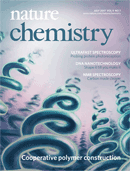 |  Editorial Editorial
 Thesis Thesis
 News and Views News and Views
 Articles Articles
 Erratum Erratum
 Addendum Addendum
 In Your Element In Your Element |  | Advertisement |  |  |  |  Call for nominations: 2017 John Maddox Prize for Standing up for Science. Call for nominations: 2017 John Maddox Prize for Standing up for Science.
Recognising the work of individuals who promote science in the face of hostility. Winners will be announced at a reception in London, as well as in Nature, and will receive £2,000. Closing date for nominations is 31st July 2017.
Click to learn more | | |
|
|
 |
|
 |
 |
Advertisement |
 |
|
 |
| |
| Advertisement |
 |
npj Clean Water: open for submissions
An open access, online-only journal, dedicated to publishing high-quality papers that describe the significant and cutting-edge research that continues to ensure the supply of clean water to populations.
Explore the benefits of submitting your next manuscript. |  | | |
 |
| |
Editorial |  Top Top |
 |
 |
 |
A chemical century p603
doi:10.1038/nchem.2815
The launch of Nature Chemistry in 2009 prompted some criticism of journal proliferation, but 100 issues later this young offender has matured into an accepted part of the publishing landscape. |
 |
Thesis |  Top Top |
 |
 |
 |
Pasteur and the art of chirality pp604 - 605
Joseph Gal
doi:10.1038/nchem.2790
Louis Pasteur was a scientific giant of the nineteenth century, but, as Joseph Gal asks, was his most famous contribution to the understanding of chemistry — chirality — influenced more by his artistic talents? |
 |
 |
 |
Identity crisis pp606 - 607
Michelle Francl
doi:10.1038/nchem.2807
Michelle Francl reminds us that you don't need to look like Einstein to be a scientist. |
 |
News and Views |  Top Top |
 |
 |
 |
|
 |
| Advertisement |
 |
A new open access, multi-and interdisciplinary journal dedicated to publishing the finest research on both microbial biofilms and microbiomes, the journal is now open for submissions.
Explore the benefits of submitting your next research article. |  | | |
 |
| |
Articles |  Top Top |
 |
 |
 |
Cooperative polymerization of α-helices induced by macromolecular architecture pp614 - 622
Ryan Baumgartner, Hailin Fu, Ziyuan Song, Yao Lin and Jianjun Cheng
doi:10.1038/nchem.2712

The secondary and tertiary structure of a protein has profound implications on function and catalysis. Now, both the secondary and tertiary structures of a synthetic polymer have been utilized to catalyse the polymerization of N-carboxyanhydrides. Both the folding of the resulting polypeptides into α-helices and their macromolecular organization dramatically enhance the polymerization rate. |
 |
 |
 |
Characterization of a selenocysteine-ligated P450 compound I reveals direct link between electron donation and reactivity pp623 - 628
Elizabeth L. Onderko, Alexey Silakov, Timothy H. Yosca and Michael T. Green
doi:10.1038/nchem.2781
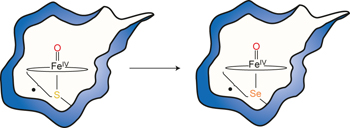
The oxidative prowess of cytochrome P450s has been suggested to stem from the electron-donating axial ligand. Now, a selenocysteine-ligated P450 compound I has been trapped and characterized providing an avenue to examine this hypothesis. Measurements reveal that the selenolate-ligated compound I cleaves C–H bonds more rapidly than the wild-type equivalent.
See also: News and Views by Fasan |
 |
 |
 |
Enantioselective, intermolecular benzylic C–H amination catalysed by an engineered iron-haem enzyme pp629 - 634
Christopher K. Prier, Ruijie K. Zhang, Andrew R. Buller, Sabine Brinkmann-Chen and Frances H. Arnold
doi:10.1038/nchem.2783
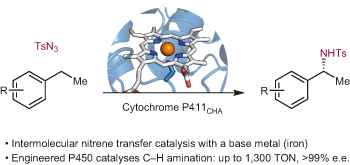
The intermolecular amination of C–H bonds is an enabling transformation for the synthesis of nitrogen-containing molecules; however, developing catalysts for this class of reactions is very challenging. Now, an iron-based enzyme for this reaction has been engineered, demonstrating that a protein can confer a difficult new function upon an otherwise unreactive base metal.
See also: News and Views by Fasan |
 |
 |
 |
π-electron S = ½ quantum spin-liquid state in an ionic polyaromatic hydrocarbon pp635 - 643
Yasuhiro Takabayashi, Melita Menelaou, Hiroyuki Tamura, Nayuta Takemori, Takashi Koretsune et al.
doi:10.1038/nchem.2764

Cooperative electronic properties that arise purely from carbon π-electrons can lead to unconventional superconductivity and quantum magnetism. New packing architectures have now been established in two caesium-intercalated polyaromatic hydrocarbons, CsPhenanthrene and Cs2Phenanthrene, both strongly correlated multi-orbital Mott insulators. The frustrated magnetic topology in CsPhenanthrene also renders it a spin-½ quantum spin liquid candidate.
See also: Article by Romero et al. | News and Views by Valenti & Winter |
 |
 |
 |
Redox-controlled potassium intercalation into two polyaromatic hydrocarbon solids pp644 - 652
F. Denis Romero, M. J. Pitcher, C. I. Hiley, G. F. S. Whitehead, S. Kar et al.
doi:10.1038/nchem.2765
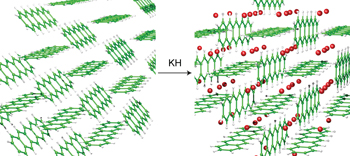
Reports of superconductivity in KxPicene spurred interest in alkali-intercalated polyaromatic hydrocarbon (PAH) compounds, but their compositions and structures have remained unclear. Now crystalline K2Pentacene and K2Picene — neither of which are superconducting — have been prepared by mild synthesis. Structural analysis shows that the cation sites arise within the molecular layers from reorientation of the PAHs within a herringbone packing.
See also: Article by Takabayashi et al. | News and Views by Valenti & Winter |
 |
 |
 |
Placing and shaping liposomes with reconfigurable DNA nanocages pp653 - 659
Zhao Zhang, Yang Yang, Frederic Pincet, Marc C. Llaguno and Chenxiang Lin
doi:10.1038/nchem.2802

Controlling liposome shape, arrangement and dynamics is important for biophysical studies and synthetic biology applications. Now, using a family of reconfigurable DNA nanocages as templates, spherical, tubular, toroidal and helical liposomes with predefined geometry have been produced. DNA-guided membrane fusion and bending is also demonstrated.
See also: News and Views by Howorka |
 |
 |
 |
Probing the early stages of photoreception in photoactive yellow protein with ultrafast time-domain Raman spectroscopy pp660 - 666
Hikaru Kuramochi, Satoshi Takeuchi, Kento Yonezawa, Hironari Kamikubo, Mikio Kataoka et al.
doi:10.1038/nchem.2717

Photoreceptors play an essential role in determining the fate of subsequent biological reactions, however, tracking their structural evolution on ultrafast timescales has been challenging. Now, photoactive yellow protein has been studied using time-domain Raman spectroscopy with sub-7-femtosecond pulses, revealing the ultrafast rearrangement of its hydrogen-bonding structure and also the structure of the first photocycle intermediate. |
 |
 |
 |
A synthetic ion transporter that disrupts autophagy and induces apoptosis by perturbing cellular chloride concentrations pp667 - 675
Nathalie Busschaert, Seong-Hyun Park, Kyung-Hwa Baek, Yoon Pyo Choi, Jinhong Park et al.
doi:10.1038/nchem.2706
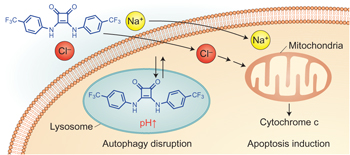
A squaramide-based anion transporter has now been shown to cause changes in the lysosomal pH leading to impairment of lysosomal enzyme activity and disruption of autophagic processes. The study provides the first experimental evidence that synthetic ion transporters can both disrupt autophagy and induce apoptosis. |
 |
 |
 |
One-thousand-fold enhancement of high field liquid nuclear magnetic resonance signals at room temperature pp676 - 680
Guoquan Liu, Marcel Levien, Niels Karschin, Giacomo Parigi, Claudio Luchinat et al.
doi:10.1038/nchem.2723
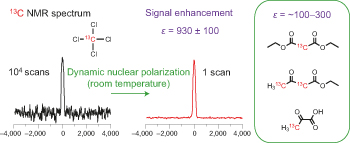
The analysis of complex (bio)molecules by NMR spectroscopy is often complicated by limitations in sensitivity. Now, it has been shown that 13C NMR signals are strongly enhanced in solution by resonant microwave irradiation of a nitroxide polarizer. This method exhibits up to one-thousand-fold improvements in sensitivity, which stands to greatly improve the detail with which small molecules and metabolites can be studied. |
 |
 |
 |
Rapid heteroatom transfer to arylmetals utilizing multifunctional reagent scaffolds pp681 - 688
Hongyin Gao, Zhe Zhou, Doo-Hyun Kwon, James Coombs, Steven Jones et al.
doi:10.1038/nchem.2672
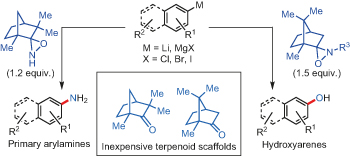
The direct transfer of primary amino and hydroxyl groups to arylmetals in a scalable and environmentally friendly fashion remains a formidable synthetic challenge. Here, it is demonstrated that bench-stable N–H and N–alkyl oxaziridines can be used as efficient multifunctional reagents, without deprotonation, for the direct primary amination and hydroxylation of (hetero)arylmetals.
Chemical compounds |
 |
 |
 |
Hypersensitive dual-function luminescence switching of a silver-chalcogenolate cluster-based metal–organic framework pp689 - 697
Ren-Wu Huang, Yong-Sheng Wei, Xi-Yan Dong, Xiao-Hui Wu, Chen-Xia Du et al.
doi:10.1038/nchem.2718
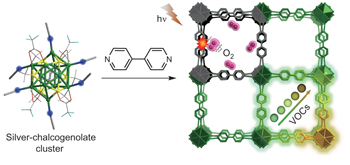
The properties of discrete species can sometimes be improved by fixing them into extended materials. This strategy has now been applied to silver(I) chalcogenide/chalcogenolate clusters, resulting in a metal–organic framework with enhanced stability and fluorescent sensing capabilities. Crystallographic analysis allows precise structural determination of guest binding, which is responsible for both emission turn-off and multicoloured turn-on. |
 |
 |
 |
Post-translational modification of ribosomally synthesized peptides by a radical SAM epimerase in Bacillus subtilis pp698 - 707
Alhosna Benjdia, Alain Guillot, Pauline Ruffié, Jérôme Leprince and Olivier Berteau
doi:10.1038/nchem.2714

Radical SAM enzymes are versatile enzymes catalysing chemically challenging reactions. Now, a radical SAM enzyme that post-translationally modifies ribosomally synthesized peptides to contain D-amino acids has been discovered in Bacillus subtilis, and its mechanism has been deciphered. These peptides, called epipeptides, efficiently inhibit bacterial growth. |
 |
 |
 |
Observation of electron-transfer-mediated decay in aqueous solution pp708 - 714
Isaak Unger, Robert Seidel, Stephan Thürmer, Marvin N. Pohl, Emad F. Aziz et al.
doi:10.1038/nchem.2727

Electron-transfer-mediated decay (ETMD) is a recently discovered type of electronic relaxation that involves the refilling of a core hole by an electron from a neighbouring species. It has now been observed in LiCl solution, when previously it had only been seen in rare-gas clusters. Spectra generated during ETMD are observed to be sensitive to the immediate environment of the initially ionized ion. |
 |
 |
 |
A polymer nanoparticle with engineered affinity for a vascular endothelial growth factor (VEGF165) pp715 - 722
Hiroyuki Koide, Keiichi Yoshimatsu, Yu Hoshino, Shih-Hui Lee, Ai Okajima et al.
doi:10.1038/nchem.2749
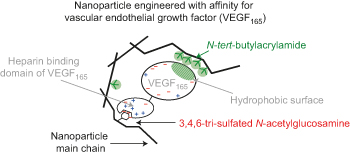
Abiotic hydrogel polymer nanoparticles with affinity for a key vascular endothelial growth factor (VEGF165) have now been developed. This high-protein affinity was engineered by carefully controlling the amount and the substitution pattern of sulfated N-acetylglucosamines and the inclusion of a hydrophobic group in the monomer. |
 |
| Advertisement |
 |
Nature Awards for Mentoring in Science — Spain
Your mentor could win €10,000
Nominations are now open | | | |
 |
| |
Addendum |  Top Top |
 |
 |
 |
Addendum: Aldehydes as alkyl carbanion equivalents for additions to carbonyl compounds p723
Haining Wang, Xi-Jie Dai and Chao-Jun Li
doi:10.1038/nchem.2805 |
 |
In Your Element |  Top Top |
 |
 |
 |
Frantically forging fermium p724
Brett F. Thornton and Shawn C. Burdette
doi:10.1038/nchem.2806
Brett F. Thornton and Shawn C. Burdette relate how element 100 was first identified in a nuclear weapons test, but that was classified information, so researchers had to 'discover' it again using other methods. |
 |
Erratum |  Top Top |
 |
 |
 |
Erratum: Tuning underwater adhesion with cation-π interactions p723
Matthew A. Gebbie, Wei Wei, Alex M. Schrader, Thomas R. Cristiani, Howard A. Dobbs et al.
doi:10.1038/nchem.2813 |
 |
 Top Top |
 |
 |
 |
| Advertisement |
 |
Nature Electronics launching
Launching in January 2018, Nature Electronics will publish both fundamental and applied research across all areas of electronics, and will incorporate the work of scientists, engineers and industry. At its core, the journal will be concerned with the development of new technologies and understanding the impact of these developments on society.
Now open for submissions, find out more |  | | |
 |
| |
 |  |  |  |  |  | Natureevents is a fully searchable, multi-disciplinary database designed to maximise exposure for events organisers. The contents of the Natureevents Directory are now live. The digital version is available here.
Find the latest scientific conferences, courses, meetings and symposia on natureevents.com. For event advertising opportunities across the Nature Publishing Group portfolio please contact natureevents@nature.com |  |  |  |  |  |
|
 |


No comments:
Post a Comment